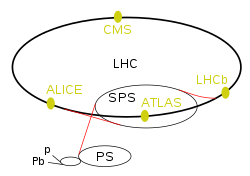MoEDAL
 |
|
| LHC experiments | |
|---|---|
| ATLAS | A Toroidal LHC Apparatus |
| CMS | Compact Muon Solenoid |
| LHCb | LHC-beauty |
| ALICE | A Large Ion Collider Experiment |
| TOTEM | Total Cross Section, Elastic Scattering and Diffraction Dissociation |
| LHCf | LHC-forward |
| MoEDAL | Monopole and Exotics Detector At the LHC |
| LHC preaccelerators | |
| p and Pb | Linear accelerators for protons (Linac 2) and Lead (Linac 3) |
| (not marked) | Proton Synchrotron Booster |
| PS | Proton Synchrotron |
| SPS | Super Proton Synchrotron |
The MoEDAL experiment is a physics experiment employing the Monopole and Exotics Detector at the Large Hadron Collider (LHC). It shares the cavern at Point 8 with LHCb, and its prime goal is to directly search for the magnetic monopole (MM) or dyon and other highly ionizing stable massive particles (SMPs) and pseudo-stable massive particles. To detect these particles, the project uses nuclear track detectors (NTDs), which suffer characteristic damage due to highly ionizing particles. As MMs and SMPs are highly ionizing, NTDs are perfectly suited for the purpose of detection.
It is an international research collaboration whose spokesperson is the University of Alberta's James Pinfold. It is the seventh experiment at the LHC, was approved and sanctioned by the CERN research board on May 2010, and started its first test deployment in January 2011.
In 2012 MoEDAL accuracy surpassed accuracy of similar experiments. A new detector was installed in 2015 from which data are yet to be analyzed.
Coordinates: 46°14′09″N 6°03′18″E / 46.235753°N 6.055092°E
...
Wikipedia
